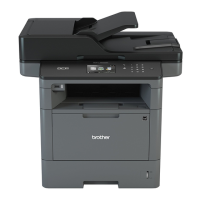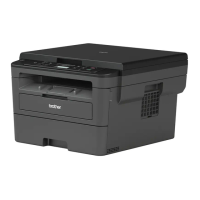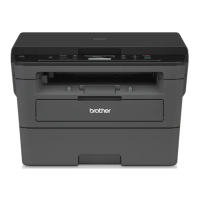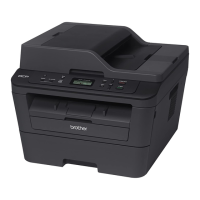Do you have a question about the Brother DCP-L5500D and is the answer not in the manual?
Lists the models covered by this user guide, including DCP and MFC series.
Explains symbols, conventions, and formatting used in the guide.
Lists registered trademarks and product names of companies mentioned in the manual.
Provides crucial notes on product usage, model variations, and documentation scope.
Confirms setup steps and discusses simultaneous operations and firewall considerations.
Details the NFC reader, Touchscreen LCD, Touchpanel, Dial Pad, Power buttons, and WiFi indicator.
Explains the two types of screens (Function and Shortcuts) and the Ready Mode screen.
Guides users on how to customize the machine's Home screen display.
Explains how to launch the Brother Utilities application on a Windows computer.
Instructions on loading paper into the main paper tray and the multi-purpose tray.
Covers changing paper size, type, and tray settings for printing.
Details how to adjust the 2-sided tray size for correct paper feeding.
Explains how to load documents into the ADF and onto the scanner glass.
Defines areas on paper that cannot be scanned, copied, or printed on.
Provides guidelines and warnings for using non-standard paper types.
Comprehensive guide to printing from a Windows computer, covering various print options.
Guide for printing from a Macintosh computer, covering document printing and options.
Details the process for duplex printing from a Windows computer.
Details how to scan directly from the machine to various destinations like folders, USB, email.
Outlines various methods for scanning from a Windows computer using Brother software.
Explains scanning methods from a Macintosh computer using Brother software.
Guides on configuring scan settings through the machine's web interface.
Basic instructions for making copies using the ADF or scanner glass.
Explains how to adjust the enlargement or reduction ratio for copied documents.
Details how to copy multiple pages onto a single sheet.
Explains how to perform 2-sided copying to reduce paper usage.
Covers all aspects of sending faxes, including manual, delayed, broadcasting, and cover pages.
Details different receive modes, ring settings, and fax detection.
Information on using PC-Fax for sending and receiving faxes from a computer.
Lists specifications for compatible USB flash drives and important notes.
Step-by-step instructions for printing photos directly from USB devices or cameras.
Guides on creating a PRN file for direct printing from a Windows computer.
Introduces network setup and supported features, recommending the installation CD-ROM.
Provides various methods for setting up a wireless connection.
Details features like mail server settings, I-Fax, LDAP search, and time synchronization.
Explains how to set a password to restrict access to machine settings.
Overviews various network security features like authentication, SSL/TLS, and IPsec.
Details how to use cloud services for scanning and printing.
Guides on using Brother iPrint&Scan for mobile printing and scanning.
Details how to use ControlCenter4 for scanning, setup, and custom tabs.
Explains how to use ControlCenter2 for scanning and machine setup on Macintosh.
Lists common error messages, their causes, and recommended actions.
Provides instructions for clearing document jams from the ADF.
Step-by-step guide to clearing paper jams from various trays and areas.
Addresses common printing issues like no printout, missing text, and poor quality.
Solutions for issues related to telephone line connections, incoming calls, and fax transmission.
Troubleshooting steps for common network connectivity issues.
Guides on replacing toner cartridges and drum units when life is over.
Instructions on cleaning the machine's exterior, scanner, touchscreen, and internal parts.
How to check the remaining life of consumables like toner and drum units.
Details how to customize settings directly on the machine's control panel.
Explains how to change machine settings using Web Based Management or Remote Setup.
Provides tables outlining menu selections and options for MFC and DCP models.
Provides detailed technical specifications for printer type, memory, power, dimensions, and noise levels.
Instructions on using the on-screen keyboard for text input on the machine's LCD.
Information on replaceable supplies like toner cartridges and drum units, including model names and approximate life.
Lists available accessories such as paper trays, with applicable models.
Explains how Active Directory restricts machine use via user ID and password.
Describes a wireless network mode where devices connect without an access point.
Defines the feature for storing names and numbers for easy dialling.
Explains the password used for wireless network security, also known as Security Key or Encryption Key.
Details the wireless connection method allowing devices to connect directly without an access point.
| Printer Type | Laser |
|---|---|
| Functions | Print, Copy, Scan, Fax |
| Print Resolution | 1200 x 1200 dpi |
| Duplex Printing | Yes |
| Paper Capacity | 250 sheets |
| Scan Resolution | 1200 x 1200 dpi |
| Operating System Compatibility | Windows, macOS, Linux |
| Processor | 600 MHz |
| Memory | 256 MB |
| Display | 2-line LCD |
| Monthly Duty Cycle | 50000 pages |
| Max Paper Size | A4 |
| Connectivity | USB 2.0, Ethernet |
| Dimensions (W x D x H) | 16.1 x 12.5 in |
| Automatic Document Feeder (ADF) | Yes |











